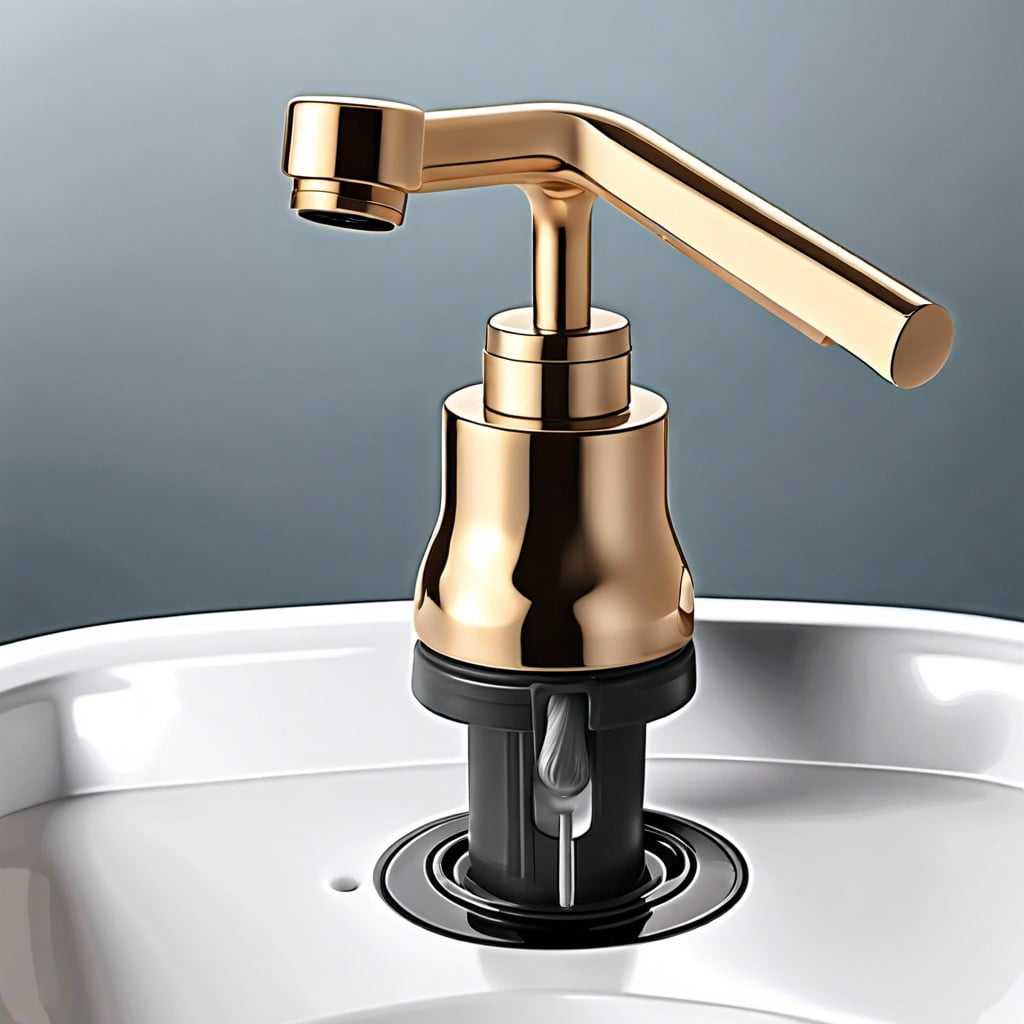Last updated on
Learn how to fix your sink stopper quickly and easily with our straightforward steps.
Key takeaways:
- Gather necessary tools and materials before starting.
- Unscrew the pop-up stopper carefully using a wrench or pliers.
- Clean the stopper and drain thoroughly to remove any grime.
- Remove the sink stopper by loosening the nut and pulling out the pivot rod.
- Reassemble the sink stopper by inserting it back into the drain hole and adjusting the lifting rod if necessary.
Before You Begin

Gather your tools and materials first. You’ll need a wrench, pliers, a bucket, and some cleaning supplies like an old toothbrush and dish soap. Also, grab a flashlight because sink cabinets are basically the caves of the modern home.
Turn off your water supply—you don’t want a mini geyser in your bathroom. Locate the valves under the sink and twist them clockwise. If they’re stuck, use a bit of gentle persuasion with those pliers you just fetched.
Clear the area under your sink. You’ll need space to work. Plus, who knows what treasures lurk in the dark recesses of your bathroom cabinet? Maybe an old hairbrush or half-used bottle of shampoo.
Unscrew the Pop-Up Stopper
Alright, roll up those sleeves and grab a flashlight. First, look underneath your sink. You’ll spot a long horizontal rod connected to a round nut at the back of the drainpipe. This rod is the key to unscrewing everything.
Now, carefully loosen the nut by turning it counterclockwise. If it’s as stubborn as a cat in a bath, use pliers, but gently—no one wants a broken pipe tantrum. Once the nut is off, slide the rod out. It might feel a bit sticky, so don’t be afraid to wiggle it.
Remember, you’re not dismantling a rocket ship; it’s just a sink stopper. Keep track of these small parts, like a squirrel hoarding nuts; losing them will definitely be a headache later!
Clean the Stopper and Drain
Now that you’ve unscrewed the pop-up stopper, let’s make it shine. First, grab a pair of rubber gloves. You never know what kind of gunk and goo awaits.
Running warm water over the stopper helps loosen the grime. A scrub brush or even an old toothbrush can be particularly effective for scrubbing off the stubborn bits.
For the drain, use a combination of baking soda and vinegar. Pour a good amount of baking soda down the drain, followed by vinegar. Watch it fizz like a grade-school volcano project. It’s satisfying and gets rid of minor blockages.
Rinse thoroughly with hot water to ensure all residue is flushed away. A clean stopper and drain make everything function smoothly and keep you from having to fish around for a stray toothpaste cap in the future.
Remove the Sink Stopper
Now comes the fun part: actually taking the sink stopper out. Ready?
First, find the pivot rod underneath your sink. It’s that wiggly little bar sticking out from the drainpipe. Loosen the nut that keeps it in place.
Carefully pull the pivot rod out from the drainpipe. It might resist, like a cat at bath time, but stay firm and gentle.
Once it’s free, the stopper should lift out easily from the sink. If it doesn’t, jiggle it a bit – stoppers love a good jiggle.
And there you go! The stopper is now out and your victory dance is optional but encouraged.
Reassemble the Sink Stopper
Make sure everything is sparkling clean, then grab the sink stopper and the pivot rod. First, insert the stopper into the drain hole. It should sit comfortably like a cat in a sunny spot.
Next, slide the pivot rod back through the same hole it came from, making sure to catch the loop of the stopper. This is like threading a needle, except less likely to result in pricked fingers.
Once the pivot rod is in place, tighten the retaining nut, but not too tightly. It should be snug, not Hulk-smash tight.
Test the stopper by pulling the lift rod up and down. If it moves smoothly, congratulations—you’ve nailed it. If it’s still acting up, you might need to adjust the pivot rod’s angle. Just remember, persistence wins the day!
Adjust the Lifting Rod
Now, let’s tackle that lifting rod adjustment. This is the part that connects to the stopper and allows you to lift it up and down.
First, locate the clevis screw, which is typically a small screw on the vertical rod. Loosen it to allow for adjustment.
Move the lifting rod up or down until the stopper opens and closes smoothly. A stiff or stuck stopper often just needs a little tweak here.
Tighten the clevis screw once you find the perfect position. Make sure it’s snug but not overly tight.
Test the stopper. If it still doesn’t work properly, you might need to adjust it a bit more or check for any obstructions.
Voilà, your lifting rod should now be working like a charm.
When to Call a Professional
If you’ve followed every step meticulously and your sink stopper still refuses to cooperate, you might wonder if it’s time to call in the pros. Here are a few good signs:
First, if the stopper mechanism is rusted or broken beyond recognition—like it’s done ten rounds with a coffee grinder—then it’s time for some expert intervention. Professionals can replace components without turning your bathroom into a crime scene.
Next, water should stay where it belongs. If you’re experiencing constant leaks despite your best efforts, a plumber can sleuth out issues that aren’t visible to the naked, untrained eye.
Lastly, for those who aren’t exactly on a first-name basis with tools, it might be safer (and cheaper in the long run) to leave it to the experts. After all, you don’t want to risk ending up with a geyser where your sink used to be.
Recap




